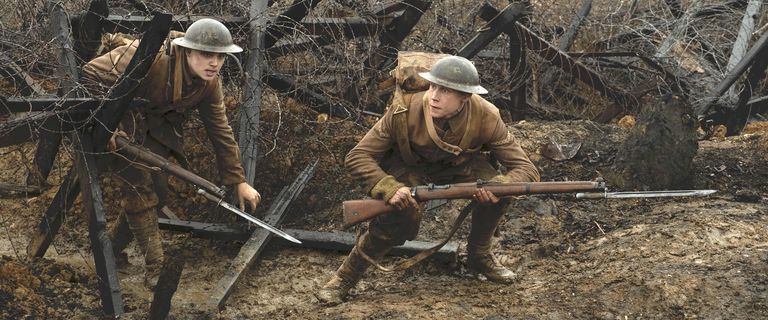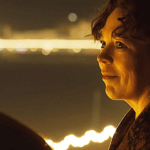Table of Contents

Photo: ‘1917’/Universal Pictures
The premise of the film 1917 is simple, yet intense. Two ordinary soldiers, played by Dean Charles Chapman and George Mackay, have to deliver a crucial message across enemy lines by dawn that could mean saving 1600 American lives, and among them happens to be one of the protagonist’s brother. We follow behind these two characters in an action epic as they tread through enemy territory, never knowing what lurks behind any corner. Though, yes, we are introduced to some emotional stakes, the film does not pour its heart into that. Most of the thrill and excitement of 1917 comes from the unique cinematography and direction, done by Sam Mendes and Roger Deakins. Sam Mendes, already having critical acclaim for Skyfall, takes the war film in a new direction by making it in a “one-shot”style. This technique was famously done by Birdman in 2014 and went on to win Best Picture. The stakes are much higher with this film’s storyline than Birdman, thus heightening the tension within the film. With this way of storytelling, we feel as though we are a part of the film walking, running, hiding alongside the two leads.
The one-shot style was integral for our immersion into the film and also makes us feel emotionally invested.
Sam Mendes elaborated in an article from Entertainment Weekly about his enormous decision to make this film in this one-shot style, “From the very beginning, I felt this movie should be told in real time. Every step of the journey, breathing every breath with these men, felt integral, and there’s no better way to tell this story than with one continuous shot.” I would wholeheartedly agree with Mendes on how crucial the camera work was to this film. The way that the film is shot is reminiscent of a video game, such as Red Dead Redemption or Call of Duty. The reason why this style works so well for this film is because we feel as though we are there with them, on this mission, we feel as if these threats are real. There is no time to breathe or relax in this film. Even when George Mackay or Dean Charles Chapman do stop for a moment to rest, you are acting as a third member of their team, searching corners or behind trees for enemies that they might have not spotted. Since you do not know what the soldiers could be facing, you are on the edge of your seat the entire length of the film, concerned as to whether they would live or die.
Video: Behind the scenes of ‘1917’/Hollywood Insider YouTube Channel
The silence and uncertainty of war is the most dangerous, as Sam Mendes shows us.
Sam Mendes manages to capture the unsettling tranquility of war throughout this film, which we do not often see onscreen. He utilizes gunfights, confrontations, and explosions sparingly. Instead the approach that he takes is more of a disquieted, tenuous one. We feel as though these two soldiers are mice entering a lion’s den. The best, and most thrilling moments, actually are of when the soldiers are creeping around dark corners or sneaking around in trenches. The sparse use of action in the film makes it seem all the more intense when we have those moments of conflict. We, as audience members, also feel more tension building up perfectly for two or three giant life-or-death scenes. The sound design is also a key element to all of this. With an incredible, heart-pounding score by Thomas Newman, 1917 would not be nearly as exhilarating without it. From his signature light piano notes, to his powerful strings, he creates one of the most moving and thrilling scores I have heard in a long time.
Mendes wonderfully recreates 1900’s France with grand set pieces and thousands of extras.
The costumes and set pieces were a feat unto themselves. We spend much of the beginning of this film walking through the elaborate maze of the American and German trenches and bunkers. We get many fantastic 360 degree shots that display the scene that the characters are in, and to create such a world of believability and immersion is astounding. We see run down, muddy roads, broken down bridges, beautiful grassy farms, burned and destroyed villages, and more. There are thousands of extras, in full costume and make-up, with battle scars and all, just to enhance the believability of this world. We never see the same location twice, which is enormous work on the production team. Kudos to them. Not only was this a giant task, but it shows the range and length of land covered in war. You could go from the calm of a farm to the chaos to a burning village during the course of a day. Everything felt raw, real, yet beautiful. I felt a part of this world, this story, I was completely immersed in it.
By Stephanie Bock
More Interesting Stories From Hollywood Insider
– Stop Pitting Duchesses Kate Middleton & Meghan Markle Against Each Other, Both Can Be Great Without The Other Being Torn Down
– Video: A ROYAL Rendezvous At The Premiere of ‘1917’ with Richard Madden, Sam Mendes, George MacKay, Dean-Charles Chapman, Prince Charles, Andrew Scott & Team
– Video: Come Behind The Scenes of Oscar Worthy & Golden Globes Nominated “1917” With Director Sam Mendes, George MacKay, Dean-Charles Chapman & Team
– Video: Full Commentary & Reactions From Stars On ‘Bombshell’ With Charlize Theron, Nicole Kidman, Margot Robbie, Jay Roach & Team
– A Tribute To The Academy Awards: All Best Actor/Actress Speeches From The Beginning Of Oscars 1929-2019 | From Rami Malek, Leonardo DiCaprio To Marlon Brando & Beyond | From Olivia Colman, Meryl Streep To Bette Davis & Beyond
– Why Queen Elizabeth II Is One Of The Greatest Monarchs | Her Majesty Queen Elizabeth II of United Queendom of Great Britain & Northern Ireland

Stephanie Bock is a writer for Hollywood Insider. She is an impassioned storyteller who puts all of her energy into her writing and film. Having grown up with a strong passion for both literature and cinema, she now writes short stories, scripts, and film reviews in her spare time. As a fan of films and shows of all kinds, she enjoys discussing deep and meaningful cinema and uncovering hidden gems.








